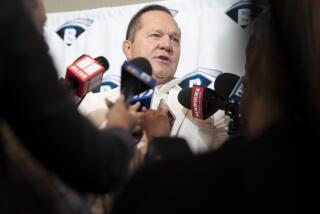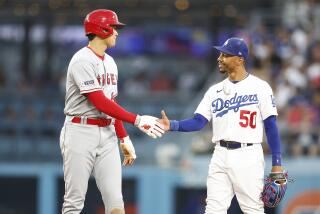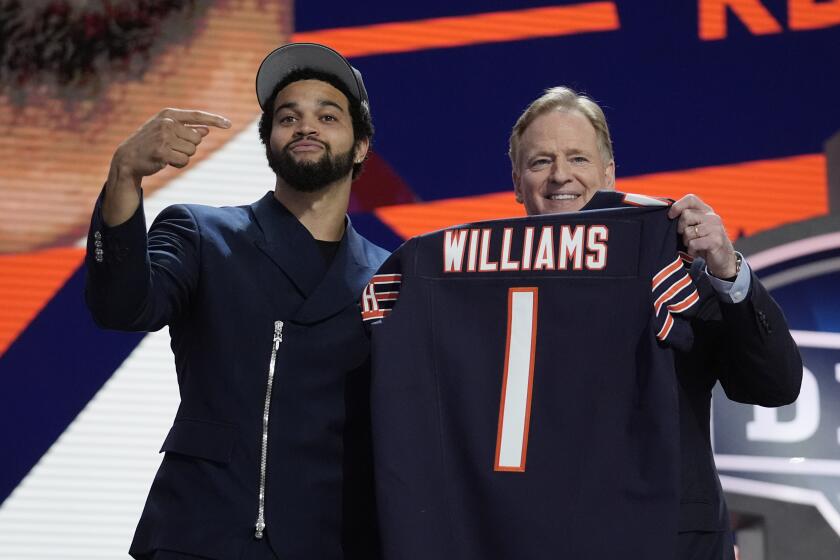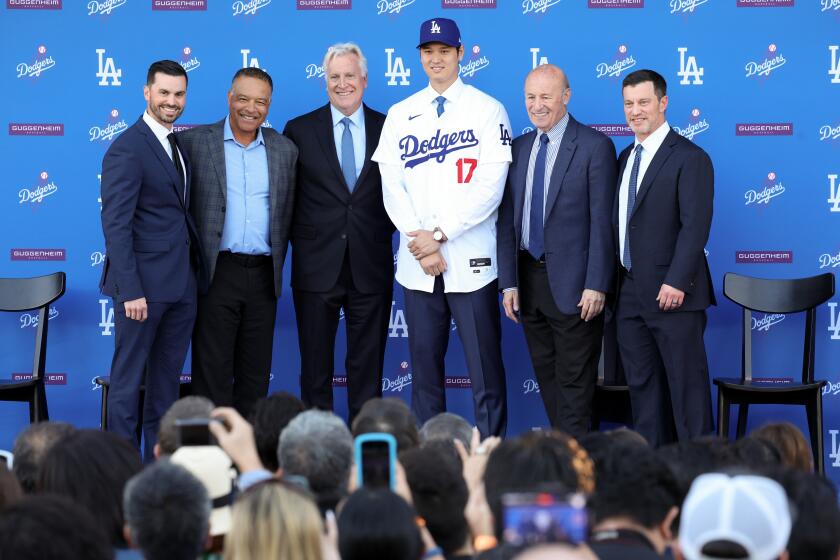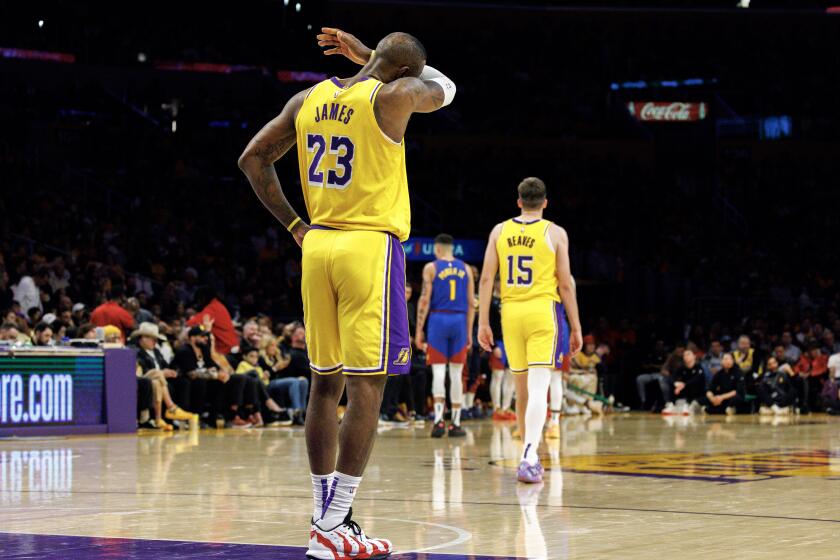From Zack Greinke to closers, five questions leading into baseball’s winter meetings
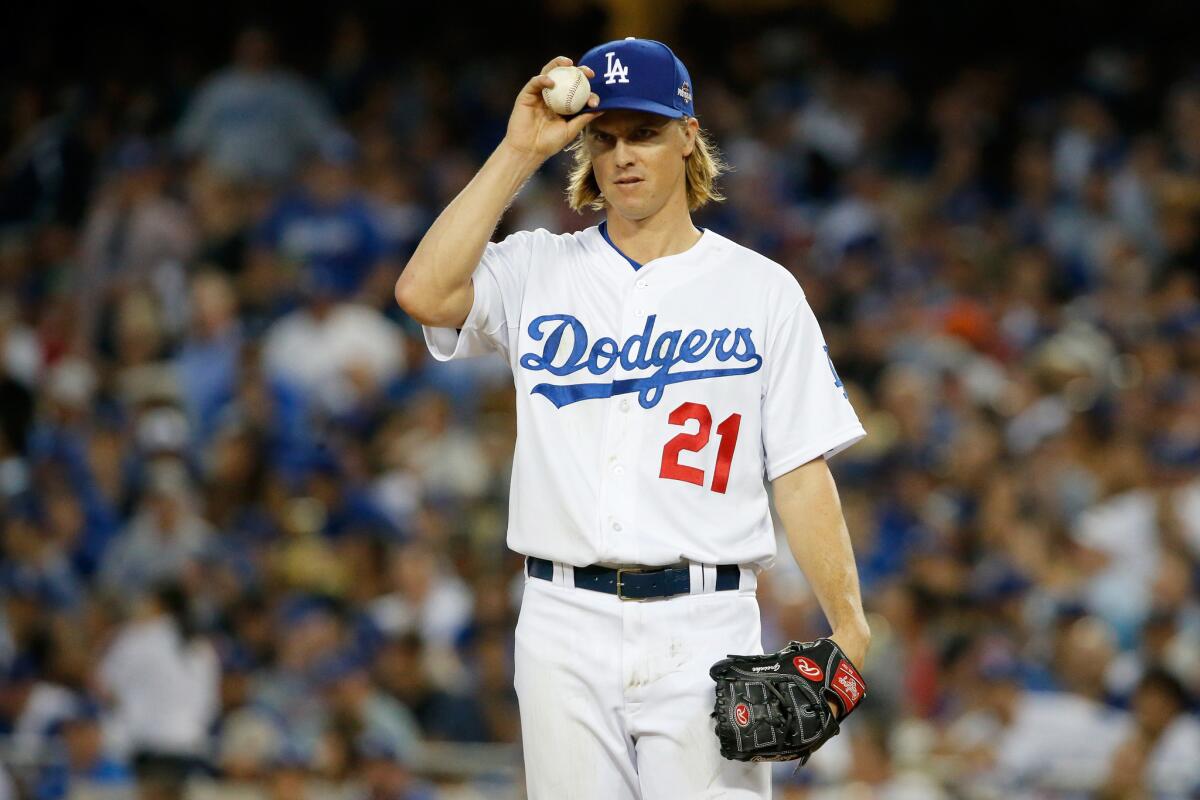
Dodgers pitcher Zack Greinke reacts during Game 5 of the National League Division Series against the New York Mets on Oct. 15 at Dodger Stadium.
David Price flashed his smile for the cameras, modeled his new Boston Red Sox jersey, then joked about his postseason record. The highest-paid pitcher in baseball history has started eight postseason games. He has won none of them.
“I guess I was just saving my postseason wins for the Red Sox,” Price said at his introductory news conference Friday in Boston.
And then Price could take his $217 million and go home to Nashville, the place where a few of his peers should find millions of pots of gold this week.
The winter meetings open Monday in Nashville. Five questions for the hottest week of the Hot Stove League:
1. Is the pendulum swinging back toward well-paid closers?
The rise of the sabermetrics has depressed the value of a closer, with the general theory that the last three outs of a game should be no harder to secure than the previous three, and that no job is more overpaid than the one in which a pitcher works one inning with a three-run lead, in maybe one of every three games.
But the Kansas City Royals have appeared in the World Series in consecutive years with shoddy starting pitching, the best bullpen in baseball and a lockdown closer. The Boston Red Sox just traded four prospects and took on $25 million to obtain closer Craig Kimbrel. The Detroit Tigers, saddled with years of ninth-inning failures, acquired closer Francisco Rodriguez, who will receive $7.5 million at age 34.
The market might be so robust that two teams have dangled what might otherwise be untouchable closers, Andrew Miller of the New York Yankees and Ken Giles of the Philadelphia Phillies, to see how strong the return in trade might be. The player to watch is Aroldis Chapman, the Cincinnati Reds’ 100-mph closer. If a team gives up top prospects for Chapman, who will be paid a projected $13 million next season and can become a free agent thereafter, a renaissance among closers might be upon us.
Dodgers closer Kenley Jansen is projected to make $11 million next season, his last before he is eligible for free agency.
2. What is the biggest logjam in the free-agent market?
Although pitchers have started to sign — from Price at $217 million and Zack Greinke at $206 million, to Jordan Zimmermann at $110 million and Jeff Samardzija at $90 million, and to J.A. Happ at $36 million and Marco Estrada at $26 million — the outfielders are in a holding pattern.
The top four outfielders, Jason Heyward, Alex Gordon, Justin Upton and Yoenis Cespedes, are corner outfielders. The Angels could double down on defense and follow their acquisition of shortstop Andrelton Simmons by adding Heyward or Gordon, completing an outfield of Mike Trout and Gold Glove winner Kole Calhoun and helping flyball pitchers Jered Weaver, Hector Santiago and Andrew Heaney.
To get Heyward or Gordon, however, Angels owner Arte Moreno almost certainly would have to pay a luxury tax. The Angels have not exceeded the luxury-tax threshold since 2004. The Tigers, San Francisco Giants, New York Mets, Baltimore Orioles and St. Louis Cardinals also could add a corner outfielder, so the laws of supply and demand could drive contract values toward $20 million, or more, per year.
3. Who is the newest and splashiest entrant into free agency?
Kenta Maeda, who won Japan’s equivalent of the Cy Young Award this season. Maeda is 27. None of what might be regarded as the cream of this year’s pitching crop — Price, Greinke, Zimmermann, Samardzija, Johnny Cueto and Scott Kazmir — is younger than 29.
The Hiroshima Carp agreed last week to post Maeda, meaning any major league club could put up $20 million for the right to negotiate with him. The $20 million would be paid to the Carp by the winning bidder and refunded to all others. The Arizona Diamondbacks have publicly expressed interest in Maeda, and the San Diego Padres are known to have scouted him.
The Dodgers’ lineage of successful Asian pitchers includes Hideo Nomo, Chan Ho Park, Hiroki Kuroda and Hyun-Jin Ryu. The scouts who reported that Masahiro Tanaka was not worth the money no longer work for the Dodgers.
Maeda, a right-hander, was 15-8 with a 2.09 earned-run average this season. He faced 821 batters and gave up five home runs.
4. What are the Padres up to?
The Padres were the darlings of the the last off-season, importing Kimbrel, Upton, outfielders Matt Kemp and Wil Myers, catcher Derek Norris, and pitcher James Shields. Now the first two are gone, Myers is a first baseman, and the Padres would consider moving Kemp, Norris and Shields. They played all of last season without a shortstop. That position remains vacant, and now left field is too. So, too, is the back end of their bullpen, with Kimbrel and Joaquin Benoit traded.
In the three seasons preceding the 2015 makeover, they won 76, 76 and 77 games. They won 74 games last season. This seems like a frenetic example of running in place, albeit with brown uniform tops for Friday home games next season and blue camouflage tops for Sunday home games.
5. Who wins in the Greinke signing, besides Greinke and the Diamondbacks?
It’s a huge win for the players’ union, and potentially a huge problem for owners, that a small-revenue team would commit $200 million to one player on the eve of collective bargaining talks.
Baseball lost the 1994 World Series because the owners pushed for a salary cap. The sport has enjoyed labor peace since then because the owners have abandoned the salary cap concept. And, although the ostensible justification for a salary cap is competitive balance, baseball has far more competitive balance than the NFL or NBA, leagues with a cap.
“Parity for this sport is very important,” Angels pitcher C.J. Wilson said after a union meeting last week in La Jolla. “It’s cool to see different teams winning the World Series, different teams having a shot.”
Baseball teams can spend whatever they like, but the so-called “competitive balance tax” adds a tariff to payrolls above a certain level. The Dodgers’ tax bill was $44 million last season.
“Other teams are shackling themselves,” Wilson said. “It isn’t necessary. They’re staying so far under the competitive balance tax, because that’s the way they want to do business.”
Revenue in the sport is approaching $10 billion per year, and union chief Tony Clark said the players’ share is “as close to 50-50 as it has been in a long time.”
Two issues for owners: whether big-market owners agree to share even more revenue with poorer brethren that use that money for Greinke-like contracts that bid up the cost for All-Stars, and whether small-market owners agree to mechanisms designed to enforce spending and not pocketing shared revenue.
“The owners have their own fights with each other,” Wilson said. “The Marlins guys and the Yankees guys aren’t necessarily going to get along on everything. They will have a harder time coming to a consensus, because they’re in such different boats.”
More to Read
Get our high school sports newsletter
Prep Rally is devoted to the SoCal high school sports experience, bringing you scores, stories and a behind-the-scenes look at what makes prep sports so popular.
You may occasionally receive promotional content from the Los Angeles Times.

